Algorithmic trading relies on high-quality tools to execute strategies efficiently, minimize delays, and ensure accuracy. This guide outlines 20 tools that help traders automate processes, analyze data, and optimize performance. From low-latency VPS hosting to advanced strategy platforms, these tools cover everything you need for reliable automated trading.
Key Highlights:
- QuantVPS: Ultra-low latency hosting with 100% uptime for uninterrupted trading.
- NinjaTrader 8: Backtesting, optimization, and Monte Carlo simulations.
- TradeStation: EasyLanguage coding, walk-forward optimization, and direct broker execution.
- Quantower: Multi-broker support and C# scripting tools.
- Sierra Chart: Fast charting and C++ programming for advanced strategies.
- MetaTrader 4/5: Popular platforms for forex and CFD trading, enhanced with VPS.
- SharkIndicators (BloodHound & BlackBird): Visual strategy creation and trade management for NinjaTrader.
- Polygon.io: Real-time, low-latency market data for multiple asset classes.
- Bookmap: Heatmaps for visualizing market liquidity.
- Replikanto & CrossTrade Trade Copier: Tools for syncing trades across accounts.
Quick Comparison:
| Tool | Primary Features | Best For |
|---|---|---|
| QuantVPS | Low latency, CME proximity, 100% uptime | High-frequency trading |
| NinjaTrader 8 | Backtesting, walk-forward optimization | Strategy testing and refinement |
| TradeStation | EasyLanguage, broker-native execution | Coding and executing strategies |
| Quantower | Multi-broker support, C# scripting | Multi-platform trading setups |
| Sierra Chart | Fast charting, C++ automation | Advanced custom strategies |
| MetaTrader 4/5 | Forex/CFD trading, VPS integration | Retail forex traders |
| SharkIndicators | Drag-and-drop strategy creation | Non-coders using NinjaTrader |
| Polygon.io | API-based market data, sub-20ms latency | Data-driven strategies |
Different Trading Platforms for Algo Trading
1. QuantVPS
When it comes to algorithmic trading, every millisecond counts. QuantVPS provides the ideal hosting environment for automated trading systems, tailored specifically for futures and forex markets. With its advanced infrastructure, QuantVPS ensures your trading strategies execute with precision and speed.
Ultra-low latency infrastructure
QuantVPS delivers 0-1ms latency by leveraging strategically located servers and cutting-edge hardware. Equipped with NVMe storage and high-performance CPUs, the platform processes data instantly, eliminating delays that could affect trade execution. Its network is built on 1Gbps+ connections with unmetered bandwidth, ensuring seamless data flow.
Unlike general VPS providers that cater to a wide range of computing needs, QuantVPS is built exclusively for trading. This focus ensures consistent performance, minimal jitter, and reliable data transmission – key factors for successful algorithmic trading.
24/7 uptime guarantee
For automated systems that operate nonstop, 100% uptime is non-negotiable. QuantVPS delivers this reliability through redundant systems, DDoS protection, and automatic backups that safeguard your data during unexpected events.
The platform’s monitoring tools work around the clock, identifying and addressing potential issues before they disrupt trading. Whether your strategies are active during standard market hours or overnight sessions, QuantVPS ensures uninterrupted operation.
Seamless trading platform compatibility
QuantVPS supports major trading platforms like NinjaTrader, MetaTrader 4/5, and TradeStation, running on a Windows Server 2022 environment. This setup ensures native compatibility and provides full root access for custom configurations.
Additionally, the platform supports multi-monitor setups, allowing traders to track multiple strategies across various timeframes and instruments at once. This flexibility enhances market analysis and decision-making.
Strategic Chicago location for CME access
QuantVPS’s servers are strategically located in Chicago, placing them close to the Chicago Mercantile Exchange (CME). This proximity reduces network hops, speeding up order routing for futures-focused traders.
For those trading CME products like E-mini S&P 500 futures or crude oil contracts, this setup can make all the difference. Faster execution ensures trades are filled at intended prices, giving you a competitive edge in the high-stakes world of algorithmic trading. The infrastructure is fine-tuned for sub-millisecond execution, seamlessly integrating into your trading technology stack.
QuantVPS offers scalable pricing plans to meet different trading needs, starting with VPS Lite at $41.99/month (4 cores, 8GB RAM) and going up to Dedicated+ Servers at $279.99/month (16+ cores, 128GB RAM) for high-volume operations.
2. NinjaTrader 8

NinjaTrader 8 provides a suite of powerful tools for backtesting and optimizing trading strategies, making it a trusted choice for automated trading enthusiasts. Let’s dive into its standout features:
Backtesting and Optimization Tools
The Strategy Analyzer is at the heart of NinjaTrader 8’s capabilities, allowing traders to test strategies against historical market data. It delivers critical performance metrics such as maximum drawdown, Sharpe ratio, profit factor, and win/loss ratios – helping traders gauge how well a strategy might perform.
To refine strategies further, the platform offers walk-forward optimization, which splits historical data into training and testing segments. This process helps validate strategies and reduces the risk of overfitting, ensuring they perform well in varied market conditions.
Another standout feature is the Monte Carlo simulation, which runs countless variations of trade sequences. By simulating different drawdown scenarios, this tool provides insights into risk management and helps traders make informed adjustments to position sizing.
3. TradeStation
TradeStation combines strategy development, testing, and direct execution into a single, cohesive platform. With its EasyLanguage programming environment, it makes automated trading accessible for both experienced developers and traders with minimal coding skills.
EasyLanguage Strategy Development
EasyLanguage simplifies complex trading logic into readable, straightforward code that reflects how traders naturally think. For example, instead of complicated syntax, you can write commands like: "If Close > Average(Close, 20) then Buy next bar at market." This intuitive approach lowers the barrier to entry for strategy development.
The platform’s Strategy Development Environment offers real-time syntax checking and debugging tools, helping you identify and fix errors before they can affect your trades. Whether you’re building a simple moving average crossover system or a sophisticated, multi-timeframe strategy that incorporates volume analysis and custom indicators, TradeStation provides the tools to make it happen.
Additionally, the platform includes an extensive function library packed with pre-built tools for technical analysis, risk management, and market data processing. This allows you to focus on refining your strategy rather than spending time coding basic functions. The result? A streamlined process for optimizing and testing strategies.
Walk-Forward Optimization
TradeStation’s walk-forward optimization is a powerful tool for testing the stability of your strategy’s parameters across different market conditions. By splitting historical data into training and testing segments, this feature helps determine whether your strategy’s success is based on genuine market patterns or just overfitting to past data.
The system automates the process, rolling through your dataset to create optimization and testing cycles. This approach highlights how parameter stability evolves over time and identifies settings that perform consistently across various market environments. Detailed reports provide insights into how your strategy would have performed using parameters optimized at different points in time.
Broker-Native Execution
One of TradeStation’s standout features is its integrated broker-platform model, which ensures seamless execution. Since TradeStation acts as both the platform and broker, your strategies execute directly through their infrastructure, bypassing third-party connections and eliminating API-related delays.
Orders are sent straight from your strategy code to TradeStation’s execution servers, reducing the communication chain that often introduces delays or errors. This eliminates concerns about API disconnections, order routing issues, or synchronization problems between your platform and broker.
The platform also handles critical tasks like position tracking, margin calculations, and risk checks in real time. You’ll receive instant updates on fills, rejections, and account status without needing extra programming or monitoring tools. This direct execution model ensures reliable and precise performance, which is vital for automated trading.
Strategy Testing Features
TradeStation’s Strategy Performance Report provides in-depth insights, including data on winning and losing streaks, performance variations, and risk-adjusted returns. This helps traders understand their strategy’s strengths and weaknesses.
The platform also supports portfolio-level backtesting, allowing you to test multiple strategies at once. This feature reveals how strategies interact, whether diversification reduces risk, and how to optimize position sizing across your entire portfolio.
For even deeper analysis, trade-by-trade breakdowns highlight patterns in your strategy’s performance. You can see which market conditions yield the best results and adjust your position sizes accordingly – scaling up during favorable periods and dialing back during tougher times. This level of granularity is invaluable for fine-tuning your approach and managing risk effectively.
4. Quantower
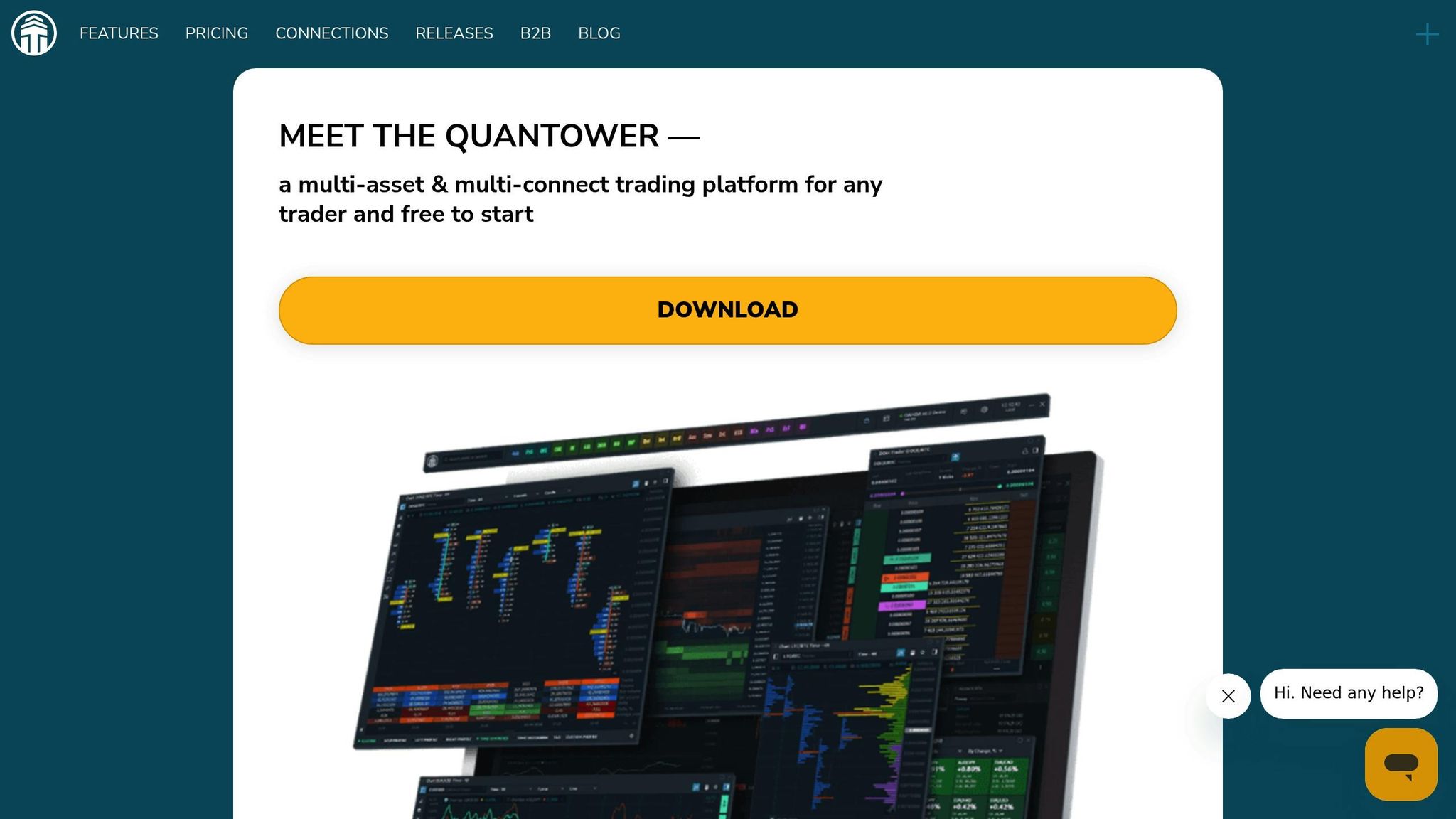
Quantower brings together data feeds and execution venues into a single, unified interface. For algorithmic traders, this means seamless access to a variety of markets and liquidity sources – all without the hassle of switching between multiple platforms. This streamlined setup paves the way for efficient multi-broker management, which we’ll dive into next.
Multi-Broker Platform Support
Quantower is designed to connect with multiple brokers at the same time, giving traders the flexibility to route orders based on execution quality or market access. This feature is especially useful for those trading across multiple asset classes or wanting to compare execution paths across different venues. By simplifying the complexities of managing various API connections, data formats, and order types, Quantower allows you to focus on what matters most: fine-tuning your trading strategies.
Scripting Capabilities
But Quantower doesn’t stop at connectivity. It also boosts development efficiency with C# scripting tools for creating custom indicators, strategies, and automated processes. The platform includes IntelliSense code completion and debugging features, making it a developer-friendly environment for those familiar with the .NET framework. Its API provides real-time access to market data, order management, and account details from all connected brokers, enabling the creation of strategies that adapt to data from multiple sources. Plus, you can design custom panels for tasks like strategy monitoring, risk management, or market analysis – all seamlessly integrated into Quantower’s interface.
5. Sierra Chart
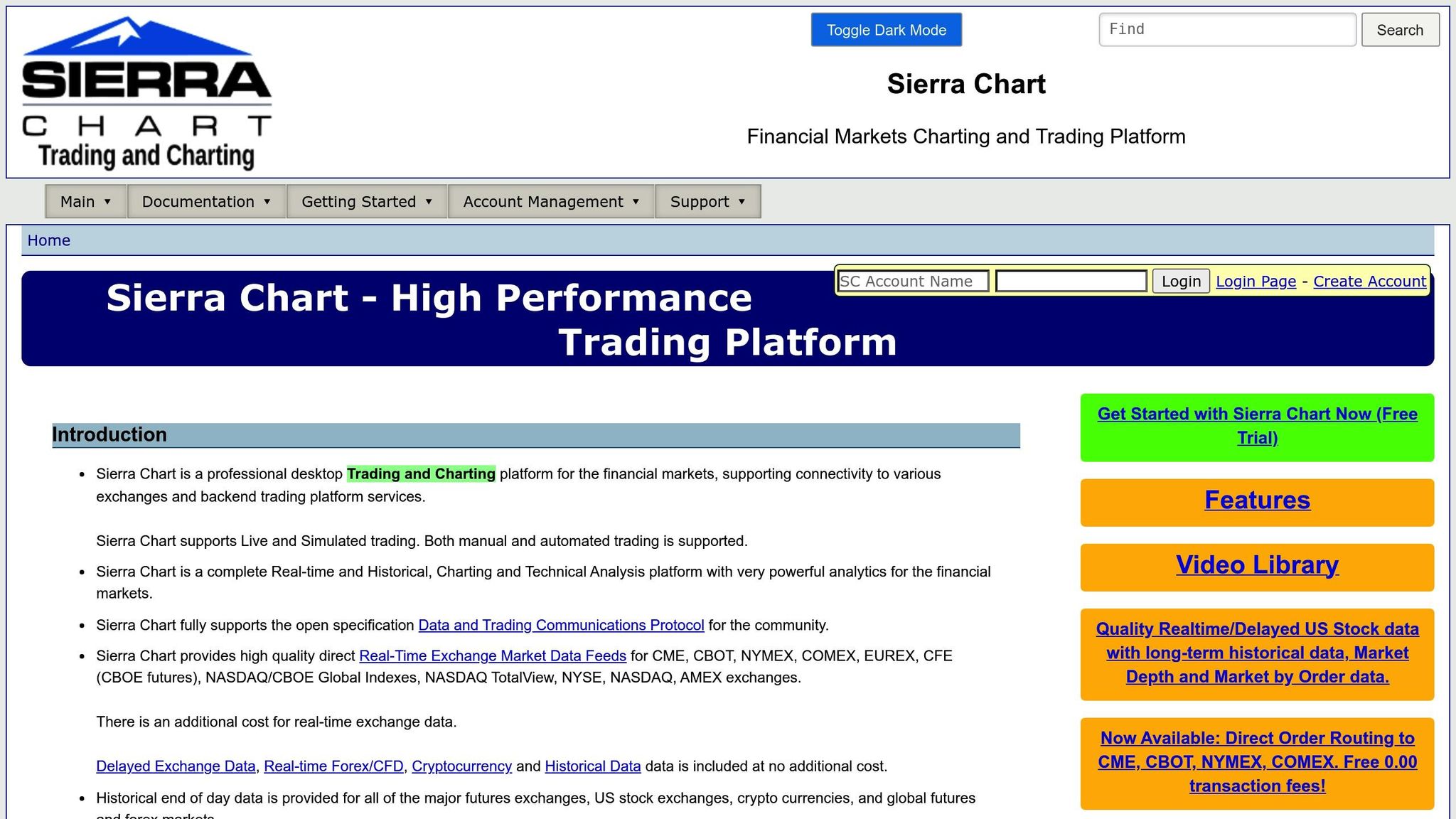
Sierra Chart is designed for traders who value speed and precision above all else. Built with performance in mind, it delivers lightning-fast execution and offers powerful programming capabilities through its native C++ environment. These features make it a go-to platform for advanced automation and detailed market visualization.
ACSIL/C++ Automation
Sierra Chart’s Advanced Custom Study Interface and Language (ACSIL) empowers algorithmic traders by providing direct access to C++ programming. This allows users to develop custom indicators and automated trading systems tailored to their strategies. Whether you’re crafting straightforward setups like moving average crossovers or building intricate multi-timeframe algorithms that process tick data in real time, ACSIL gives you the tools to bring your ideas to life.
Ultra-Fast Charting
Sierra Chart excels in ultra-fast charting, ensuring market data is processed and displayed with minimal delay. This speed is crucial for quickly spotting trading opportunities. The platform also supports multiple timeframes at once and can handle extensive historical datasets, making it ideal for backtesting strategies and analyzing long-term market trends with precision.
6. MetaTrader 4/5
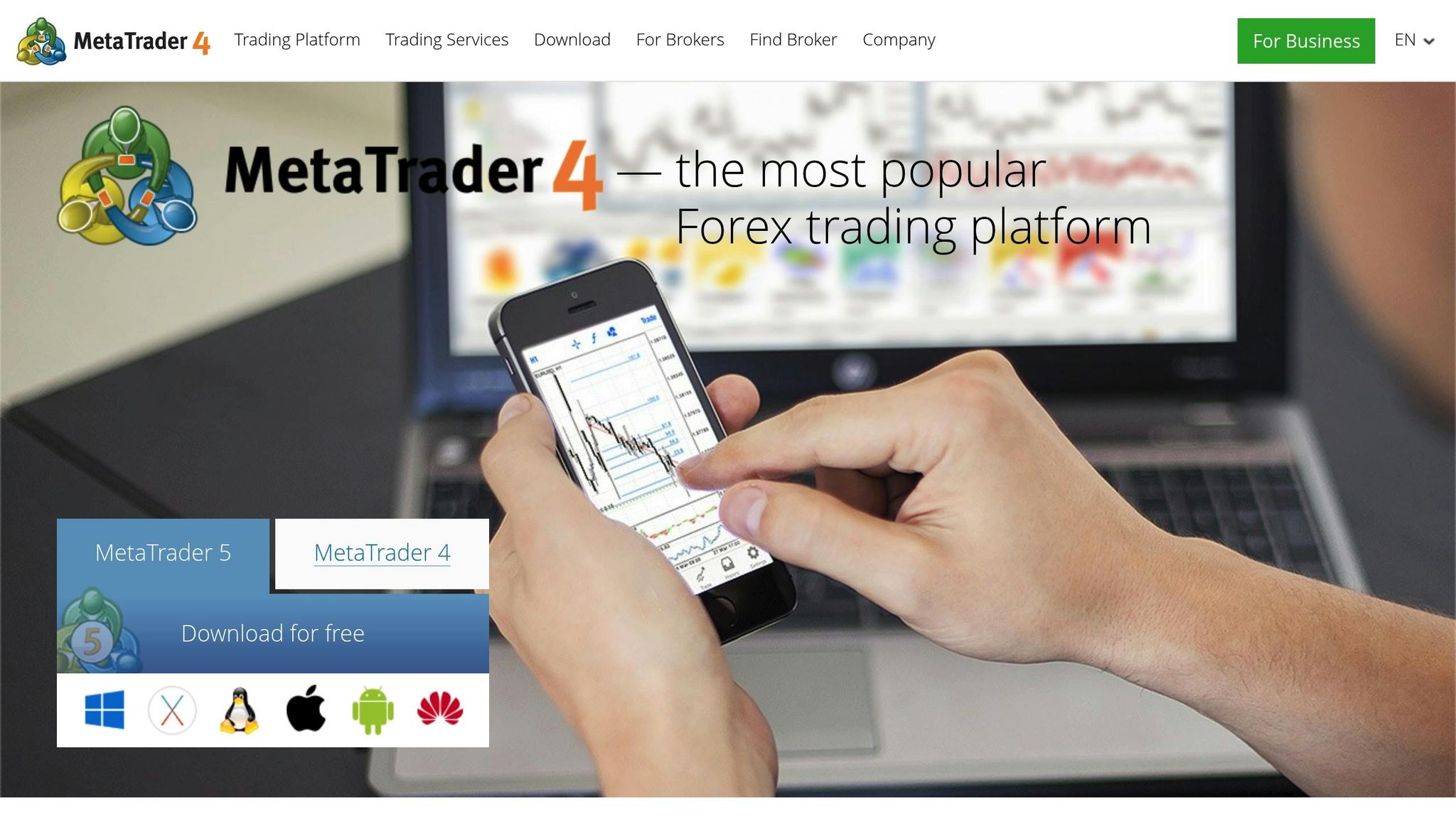
MetaTrader 4 and MetaTrader 5 are some of the most popular platforms in the forex and CFD trading world. Known for their versatility, they allow traders to automate strategies and execute trades with precision. When paired with a VPS, these platforms perform even better, ensuring smooth and uninterrupted trading.
One of the standout advantages of using MetaTrader is how well it integrates with Virtual Private Servers (VPS). By using a VPS, traders can keep their systems running around the clock, no matter the circumstances. For example, QuantVPS provides a high-performance, low-latency hosting solution that ensures MetaTrader algorithms run without interruptions. This setup is perfect for traders who rely on automation to stay ahead in fast-moving markets.
7. SharkIndicators (BloodHound & BlackBird)
SharkIndicators brings two standout tools to the table – BloodHound and BlackBird – designed to take full advantage of NinjaTrader’s powerful automation features. Together, they simplify strategy creation and enhance trade management, making them invaluable for traders looking to streamline their workflow.
BloodHound transforms the way traders develop strategies by offering a visual logic designer. Instead of diving into complex coding, users can create intricate algorithms with a simple drag-and-drop interface. This makes it easier for traders without programming expertise to design advanced strategies while still ensuring the accuracy and detail required for effective automated trading.
BlackBird, on the other hand, focuses on fine-tuning trade management. It offers advanced tools for position sizing, risk control, and exit strategies, all seamlessly integrated with NinjaTrader’s execution system. By automating key decisions – like setting profit targets and adjusting stop-loss levels – BlackBird helps traders maintain consistent risk management while removing much of the emotional pressure that comes with manual trading.
These tools bridge the gap between strategy creation and automated execution, giving traders more control and confidence in their trading processes. They highlight the importance of precision and efficiency, aligning perfectly with NinjaTrader’s capabilities.
8. StrategyQuant X
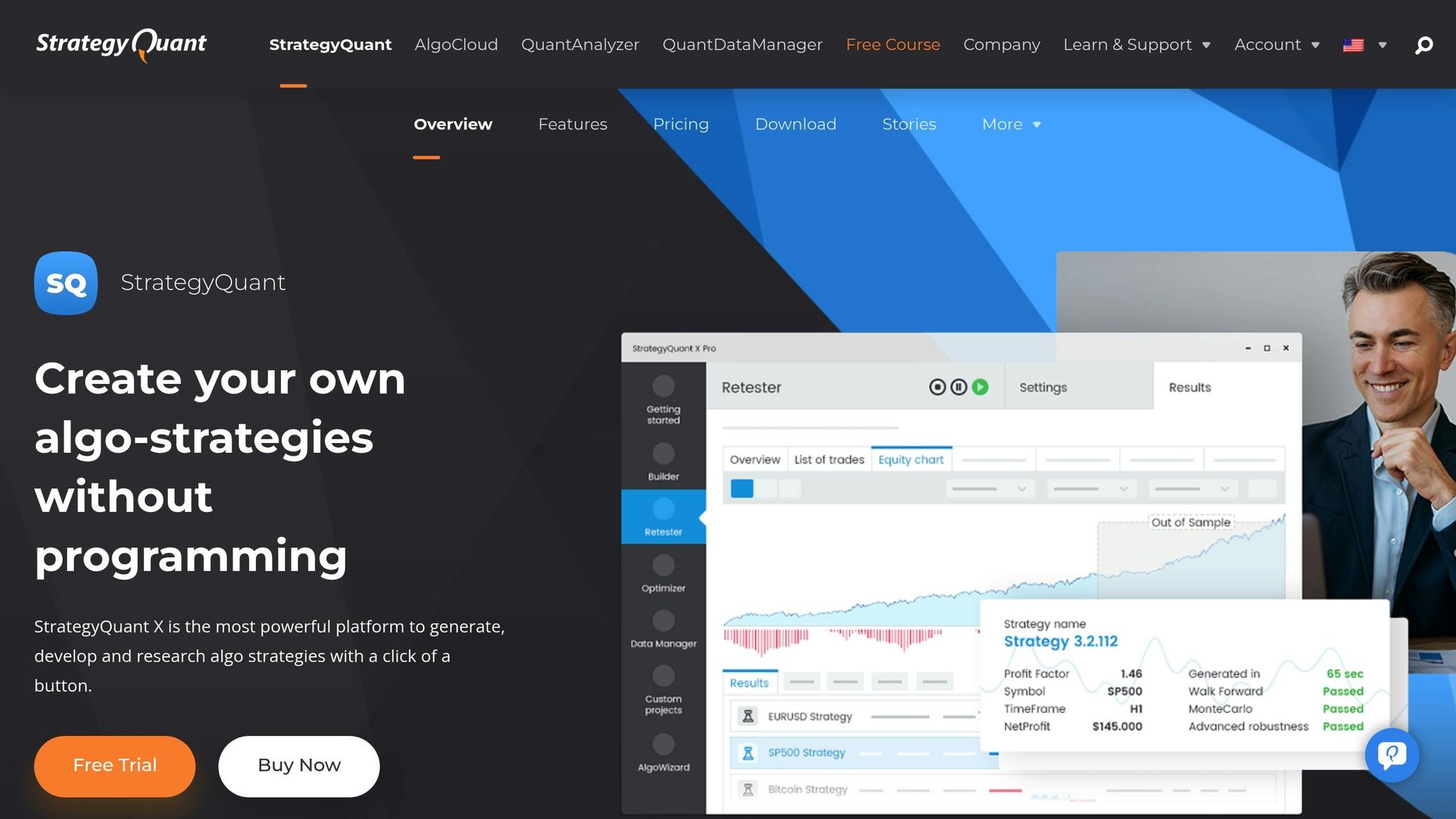
Details about StrategyQuant X are somewhat scarce at the moment, but it’s designed to improve the process of creating automated trading strategies. For the most accurate and up-to-date information, it’s best to visit the vendor’s official website.
Up next, let’s take a look at how AmiBroker delivers fast backtesting and optimization tools to refine your trading strategies.
9. AmiBroker
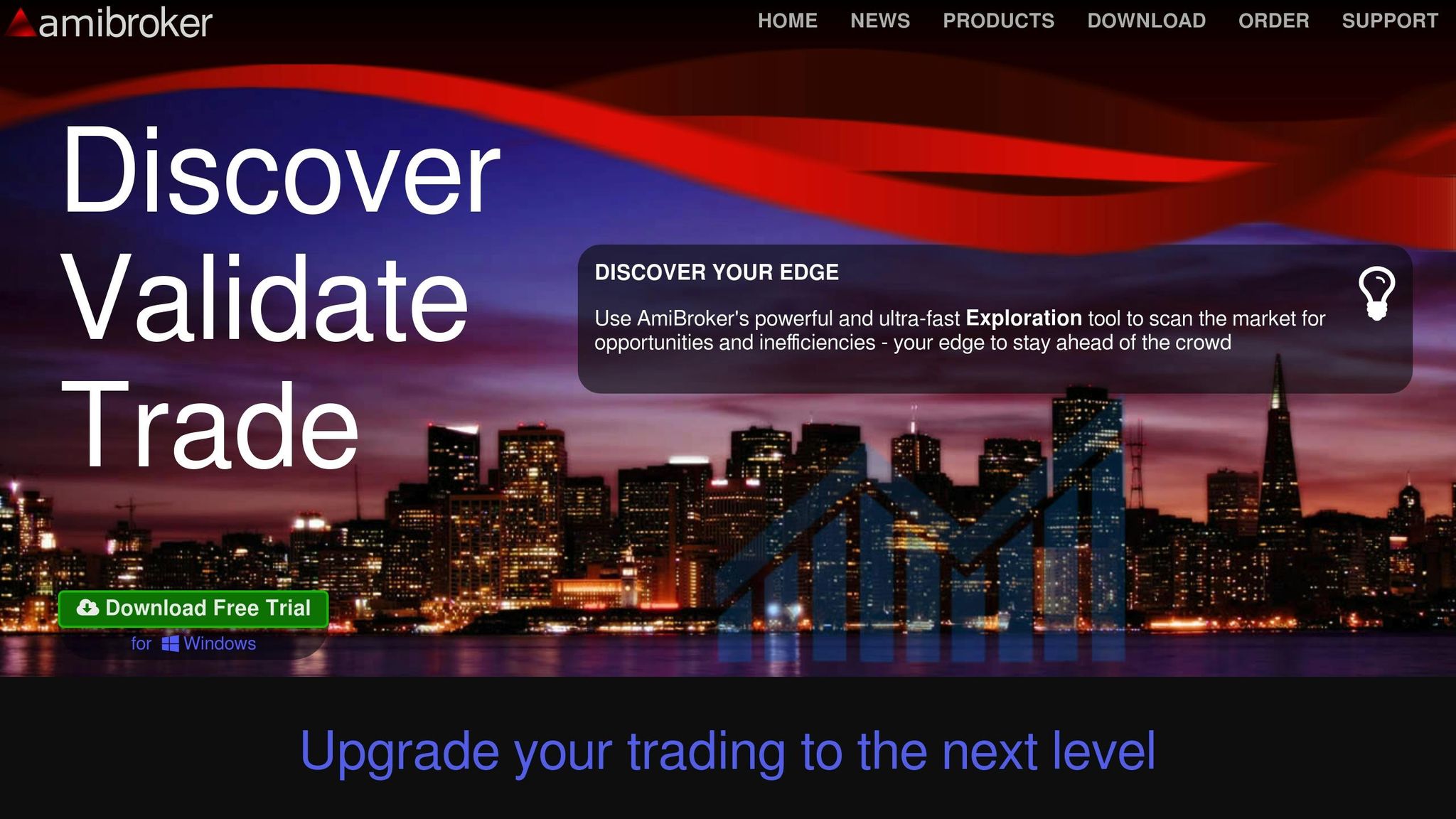
AmiBroker is a well-known platform for algorithmic trading, appreciated for its AFL (AmiBroker Formula Language) scripting system. This scripting language, with its C-like syntax, offers traders the flexibility to create both straightforward and intricate trading strategies, catering to a wide range of expertise levels.
AFL Scripting Language
The AFL scripting language allows traders to design customized indicators and strategies using array processing. This feature enables calculations to be applied across entire price series, simplifying complex data analysis. With numerous built-in functions for technical indicators and statistical tools, AFL provides a dynamic environment for building automated trading systems. For those seeking even more functionality, advanced users can integrate external DLLs to expand its capabilities further.
10. MotiveWave
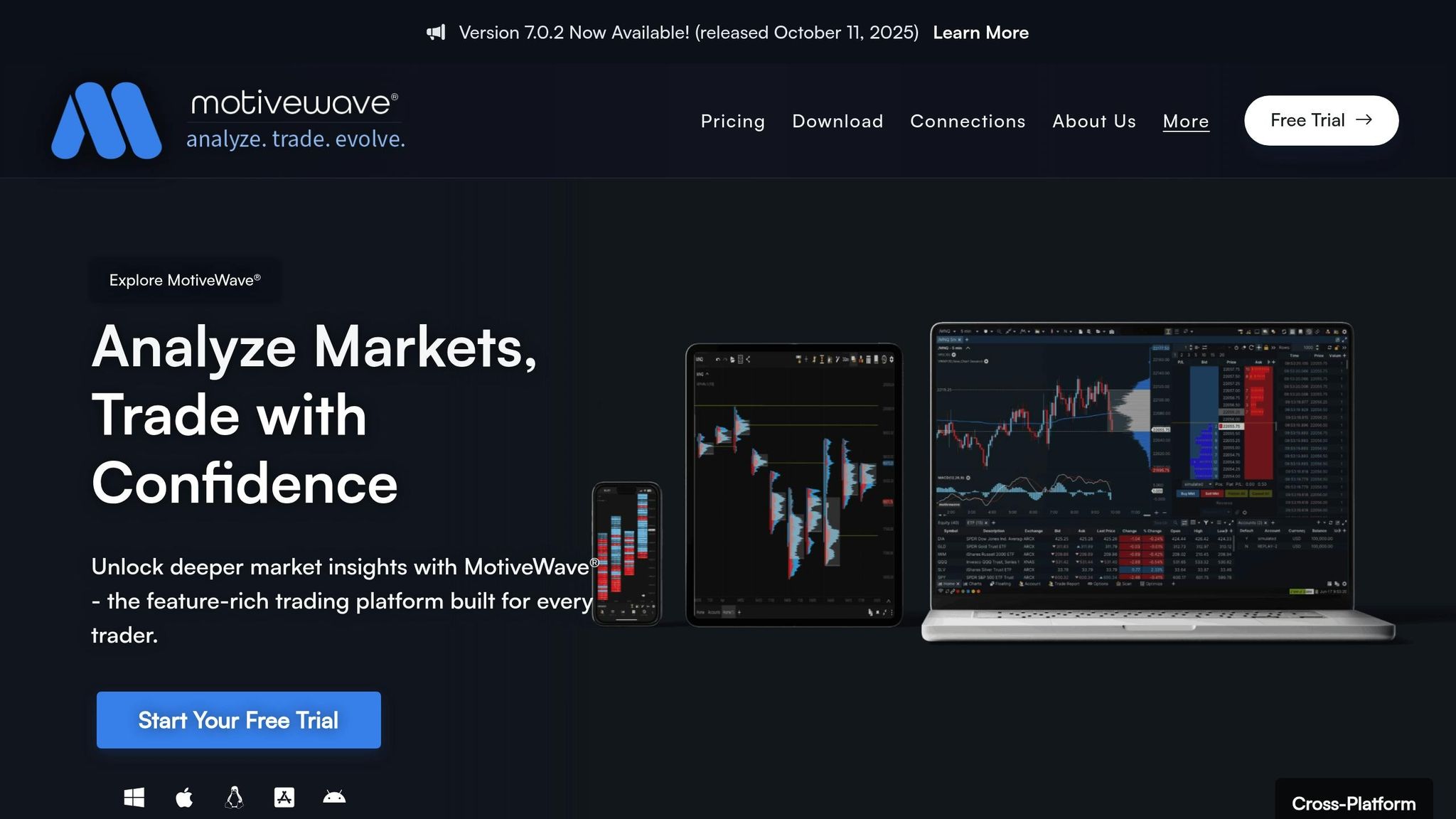
MotiveWave combines advanced charting features with robust automation tools, making it a go-to platform for detailed technical analysis and algorithmic trading.
Advanced Strategy Studio
MotiveWave’s visual strategy studio allows traders to create sophisticated trading algorithms without needing extensive coding skills. Using drag-and-drop components, you can design strategies that incorporate entry and exit rules, as well as risk management. On top of that, the platform provides specialized tools to deepen your technical analysis.
Elliott Wave Analysis
The platform also stands out with its built-in Elliott Wave analysis tools. These tools automatically detect wave patterns and label market structures in real time. With features like automatic wave counting, degree labeling, and projection capabilities, traders can better forecast price movements and reversals. Plus, these tools allow algorithms to adjust dynamically to market changes, offering a significant edge in trading.
11. Bookmap
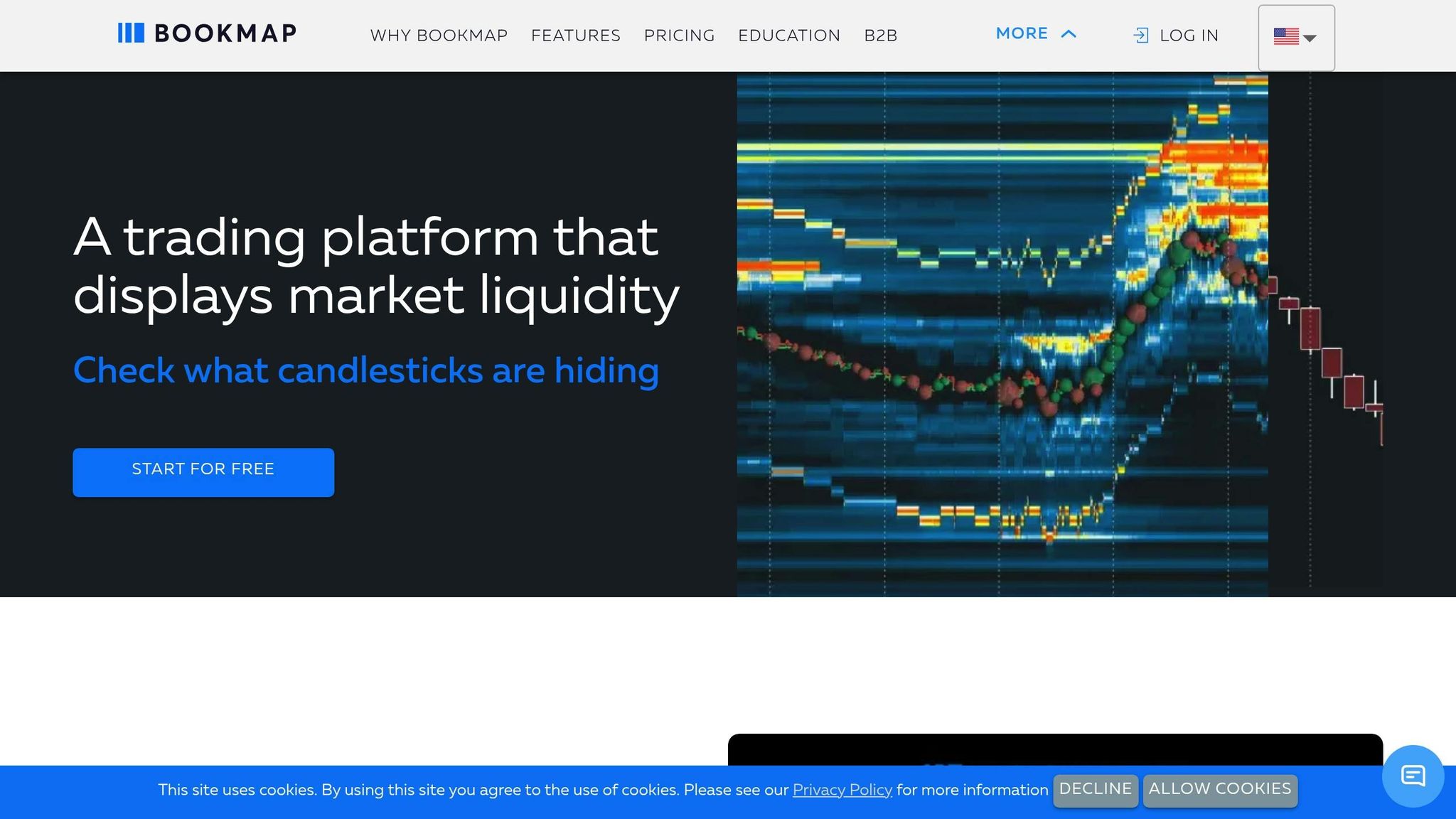
Bookmap transforms complex order book data into easy-to-understand heatmaps. This allows traders to quickly spot market liquidity and pinpoint key order levels, helping them make more informed trading decisions.
12. Jigsaw daytradr
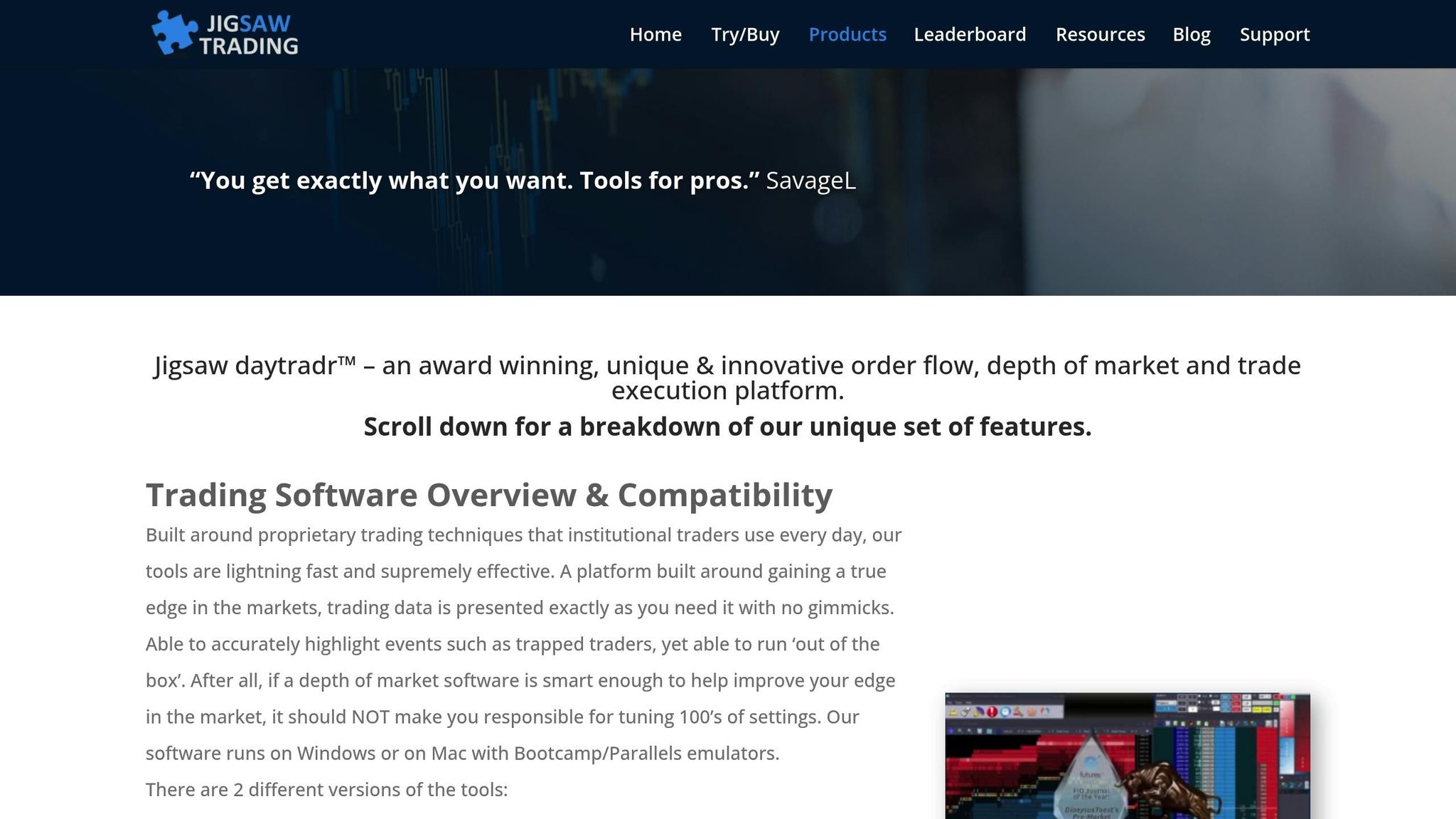
Jigsaw daytradr is all about auction market analytics and in-depth DOM (Depth of Market) analysis. It’s designed to be a helpful tool for traders who rely on real-time DOM data to fine-tune their trade management. While it doesn’t automate trading itself, it works as a companion for those using automated order management systems, adding another layer of insight to their trading strategies.
Since public documentation on Jigsaw daytradr is limited, traders should carefully explore the available information to determine if it aligns with their specific automated trading needs.
13. Trading Technologies (TT/ADL)

Trading Technologies TT/ADL is designed to provide the lightning-fast execution needed for futures trading, where every millisecond counts. Its ability to process market data and execute orders with minimal lag gives traders a crucial edge in implementing high-speed strategies.
What sets this platform apart is its user-friendly drag-and-drop interface. Traders can create automated execution rules by combining visual logic blocks, eliminating the need for advanced programming skills. These components can be used to craft anything from straightforward bracket orders to intricate multi-leg strategies.
TT/ADL has earned its reputation for reliability and speed, making it a trusted choice for traders who demand consistent performance. Like other tools in this space, it focuses on delivering the speed and precision essential for automated trading workflows.
14. IBKR API (TWS)
The TWS API from Interactive Brokers creates a direct link between your brokerage account and your own programming environment. This connection allows you to implement automated trading strategies without relying on third-party tools. With this setup, you can execute trades and keep an eye on your account activity – all within your own system.
Up next, we’ll look into how specialized data feeds and APIs can take algorithmic trading to the next level.
15. Databento
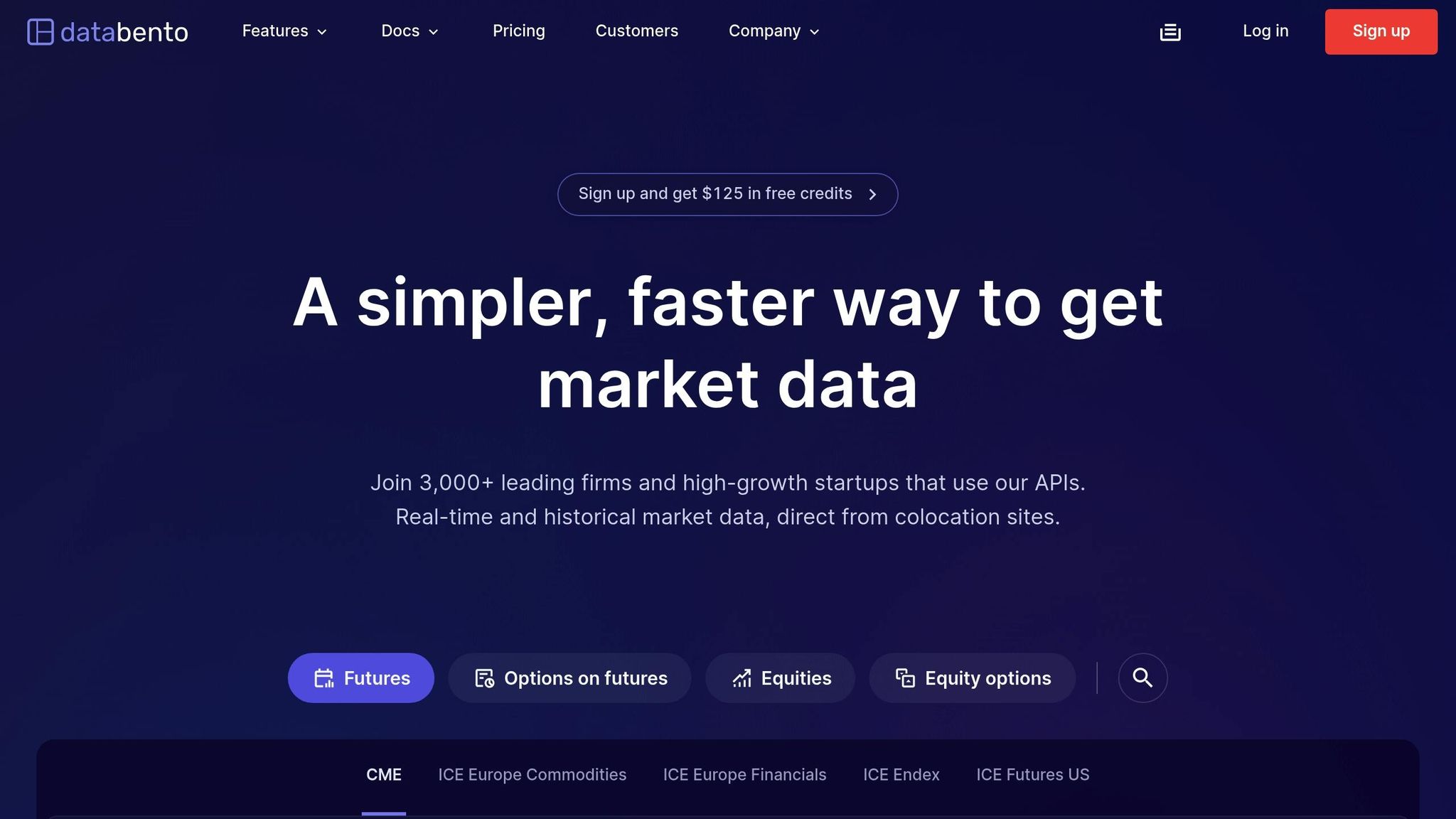
Databento provides market data through APIs, offering a streamlined way to access and integrate data into your systems. While specifics like low-latency delivery or access to historical data aren’t extensively covered in available resources, you can explore their official documentation for a full breakdown of features and capabilities.
This API-based solution fits well alongside other advanced tools, enhancing your data-driven workflows.
16. Polygon.io
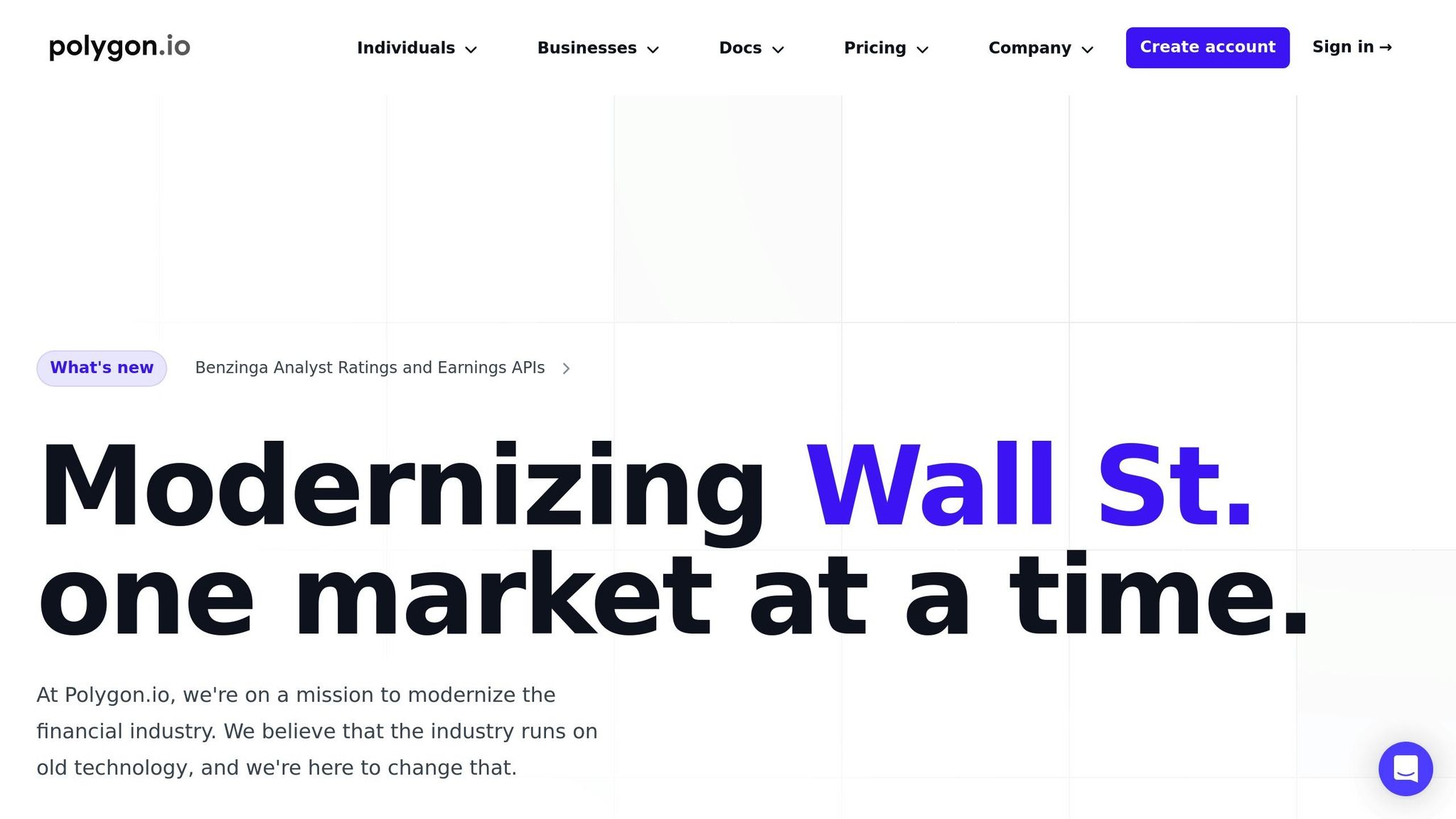
Polygon.io provides API-based market data access, covering a broad range of asset classes essential for automated trading. The platform supplies data for U.S. stocks across all exchanges, including dark pools and OTC markets. It also delivers options data from all U.S. exchanges, major indices like the S&P 500 and Dow Jones, forex and cryptocurrency pairs, and futures from CME, CBOT, NYMEX, and COMEX. This extensive data offering supports the demands of modern automated trading systems.
API-Based Data Access
Polygon.io offers three flexible methods for accessing market data: flat files via an S3 interface, RESTful APIs, and SQL query options. This allows traders to choose between bulk historical data downloads or programmatic access to live data, catering to different trading needs.
WebSocket Connections
The platform’s WebSocket APIs enable real-time data delivery and seamless integration with programming languages like Python, Java, and C++. This implementation ensures continuous data streams without the interruptions caused by repeated HTTP requests, which is crucial for maintaining smooth and consistent data flow.
Real-Time Price Feeds
Polygon.io leverages direct fiber cross-connects to exchanges, ensuring faster and more precise data delivery. By bypassing intermediaries, this direct connection minimizes delays, a critical factor for trading strategies that rely on speed and accuracy.
"Polygon.io APIs have set the standard for easy access to financial market data, and have proven to be extremely robust and reliable over the course of our partnership." – Fergus Colleran, Ops Manager, Wealth & Trading
Multi-Asset Data Coverage
Polygon.io provides real-time, institutional-grade data directly from major exchanges, with latency as low as sub-20ms. This ultra-low latency is vital for high-frequency trading and scalping strategies, where even a few milliseconds can impact profitability. The platform’s comprehensive coverage enables traders to create diversified algorithms across equities, derivatives, currencies, and commodities, enhancing their ability to adapt to various market conditions.
17. dxFeed
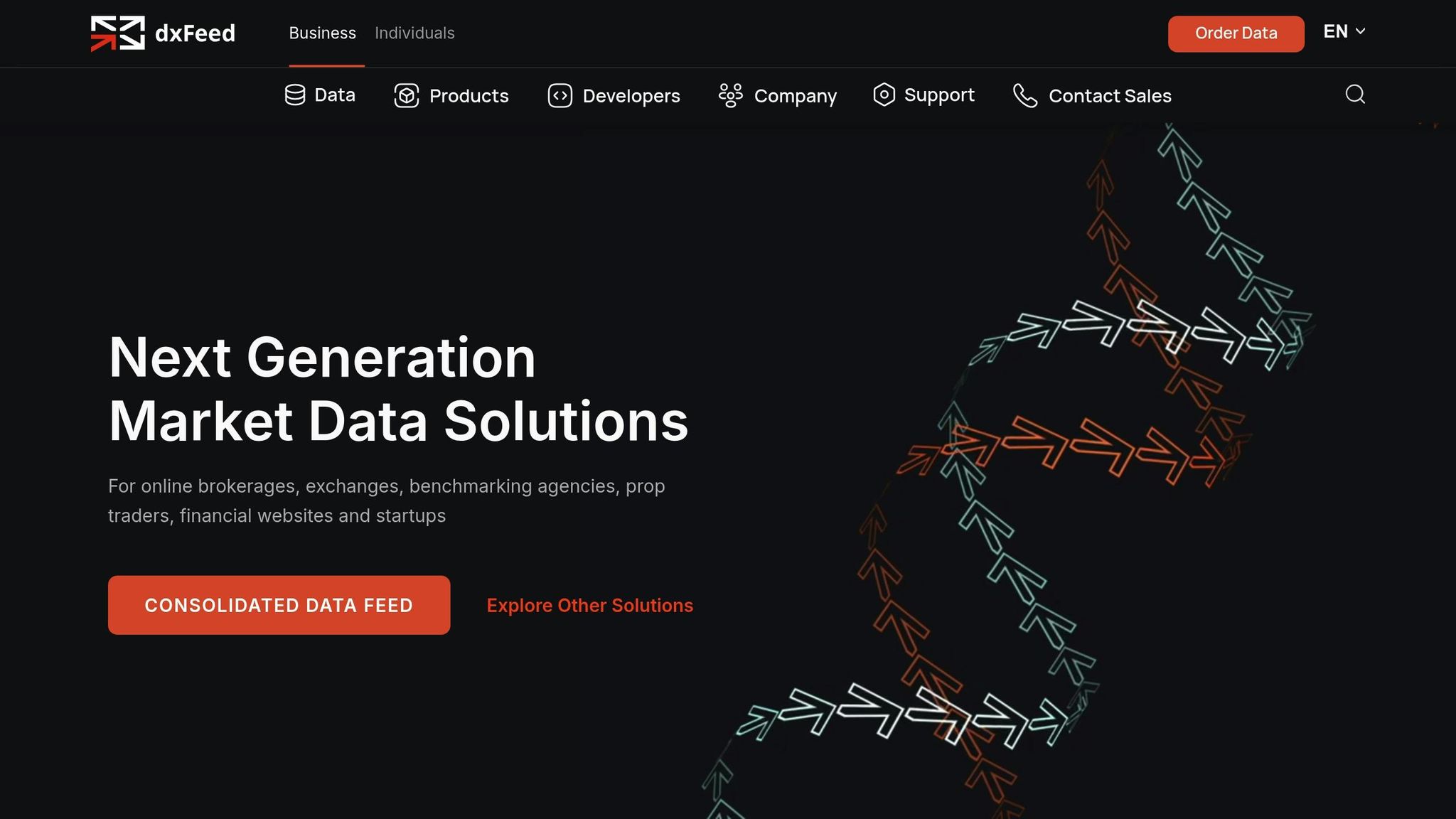
Building on the insights from Polygon.io, dxFeed offers another option for accessing market data, specifically tailored for derivatives markets like futures and options. While detailed public information about its features is somewhat limited, it’s worth exploring further to see if it matches your automated trading requirements. This addition rounds out the collection of tools critical for dependable automated trading strategies.
18. Quantower Copy Trading Panel
Quantower includes a Copy Trading Panel designed to replicate trades across multiple accounts seamlessly. This feature is fully integrated into the platform, making it easier for traders to manage and mirror activity across several accounts. It’s a convenient tool for those handling multiple portfolios, ensuring efficient and synchronized trading.
19. Replikanto (NinjaTrader)
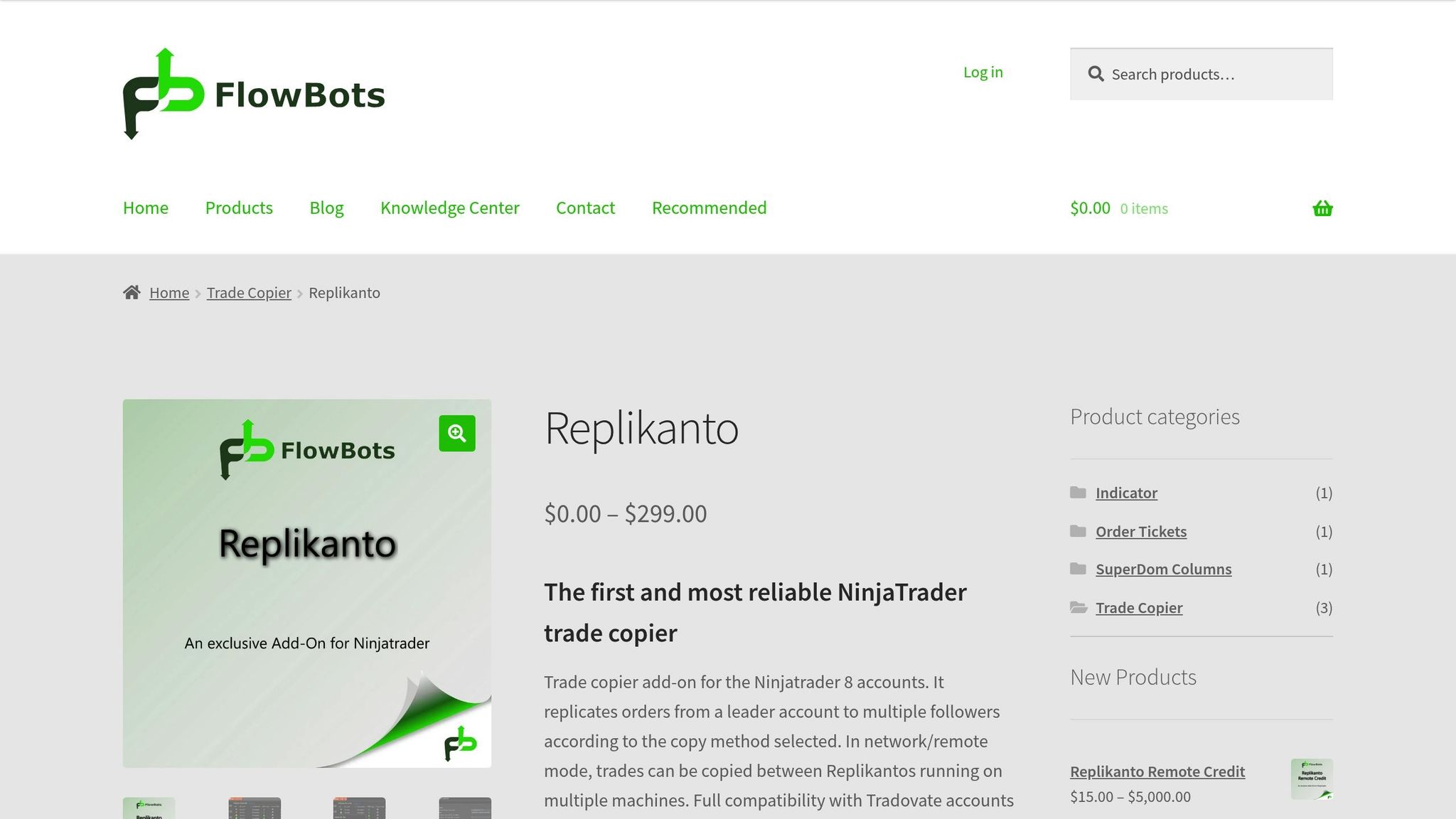
Replikanto is a trade copier designed for NinjaTrader, allowing users to sync trades across several accounts. While information on its integration features, multi-account management, and performance metrics isn’t readily accessible, it’s crucial for traders to evaluate the tool’s functionality to ensure it aligns with their specific trading requirements.
20. CrossTrade Trade Copier
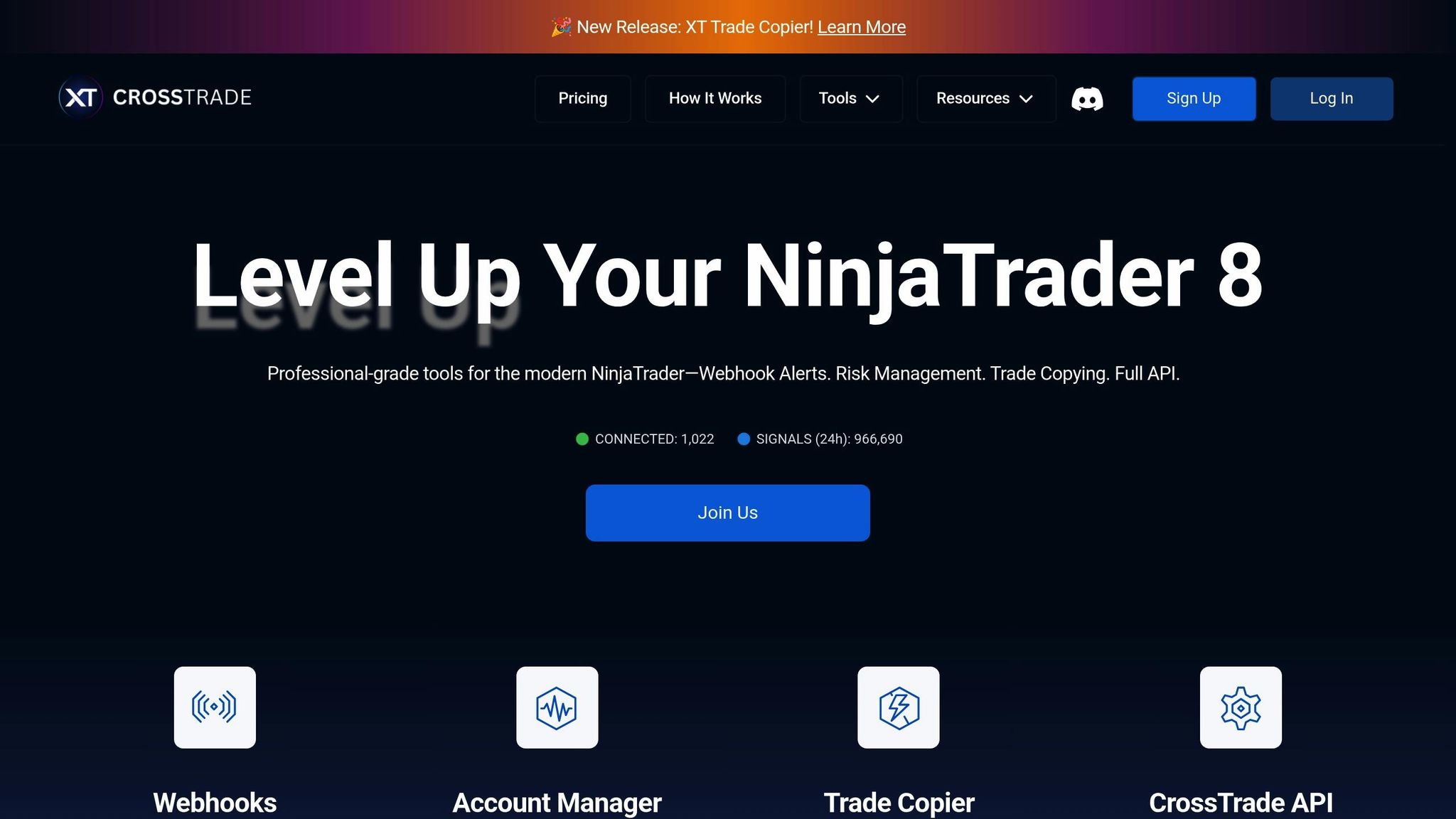
CrossTrade Trade Copier is another option in the lineup of tools designed for replicating trades across multiple accounts. While specific details about its features and capabilities are somewhat limited, the tool aims to simplify the process of trade replication. For a deeper understanding of how it works and its integration options, it’s best to refer to the official documentation.
Conclusion
Achieving success in algorithmic trading requires a seamless integration of reliable platforms, high-quality data, and dependable infrastructure. The synergy between advanced strategy builders, accurate data feeds, and efficient execution systems forms the backbone of consistent automated trading performance.
The tools discussed in this guide are most effective when used as part of an interconnected system. For instance, pairing a platform like NinjaTrader 8 with low-latency, high-quality market data enhances its capabilities, enabling precise and timely trade entries.
A dedicated trading VPS, such as QuantVPS, further strengthens this setup. With ultra-low latency and 100% uptime, QuantVPS ensures the speed and reliability essential for algorithmic trading. Hosting near Chicago, with sub-millisecond execution speeds, can be a game-changer, particularly for high-frequency trading strategies.
Dependable infrastructure and comprehensive market data also play a crucial role in backtesting and real-time execution. These elements allow traders to validate their strategies thoroughly before committing real capital, minimizing risks and increasing confidence in their systems.
Once profitability is established, scaling becomes the next logical step. Instead of relying solely on personal capital, many successful algorithmic traders partner with proprietary trading firms like FundingTicks, My Funded Futures, FundedNext, or FTMO. These firms provide access to larger pools of capital, enabling traders to scale their strategies while retaining a significant share of the profits.
This approach also helps manage risk effectively. By combining a stable VPS setup with reliable automation tools and prop firm funding, traders can scale their operations without exposing personal finances to unnecessary risks. This setup allows algorithms to operate continuously on funded capital while maintaining controlled personal exposure.
The key to success in algorithmic trading isn’t about finding a single perfect tool. It’s about assembling the right combination of tools that work harmoniously. The platforms, data feeds, execution systems, and infrastructure highlighted in this guide are the essential components of a professional-grade trading operation designed for consistent performance and long-term growth.
While the world of algorithmic trading evolves rapidly, the core principles remain steadfast: accurate data, reliable execution, robust infrastructure, and disciplined risk management. Select your tools carefully, test rigorously, and scale methodically. Together, these elements create an ecosystem built for sustained trading success.
FAQs
How can using a VPS like QuantVPS enhance the performance of my algorithmic trading strategies?
Using a VPS like QuantVPS can take your algorithmic trading strategies to the next level by delivering sub-millisecond latency and round-the-clock reliability. These features are crucial for executing trades at lightning speed and ensuring your systems stay operational, even during unexpected power outages or internet issues.
QuantVPS also offers a low-latency connection to trading servers, making it a great choice for high-frequency trading, trade copiers, and other time-sensitive strategies. Hosting your trading systems on a VPS minimizes delays, boosts execution precision, and gives you the confidence to scale your trading efforts seamlessly.
What should I consider when selecting an algorithmic trading platform from the 20 listed tools?
When choosing an algorithmic trading platform, it’s essential to focus on features that match your specific trading style and objectives. Look for platforms that allow you to efficiently create, backtest, and execute strategies. For example, NinjaTrader 8 supports advanced coding in C#, catering to traders who prefer custom programming. On the other hand, AmiBroker provides specialized scripting tools designed for quick optimizations.
Execution tools are another critical factor. Features like heatmaps, Depth of Market (DOM) analytics, and trade management tools can make a big difference in how you analyze and execute trades. Additionally, reliable data feeds and APIs are vital for accessing real-time and historical market data, ensuring your strategies are based on accurate and timely information.
Don’t overlook the platform’s infrastructure. Consider whether it offers VPS (Virtual Private Server) options for low-latency performance and uninterrupted trading. For instance, a VPS located near Chicago’s financial hubs can significantly boost execution speed and reliability, especially for automated strategies. A solid infrastructure ensures your system runs smoothly, even in volatile market conditions.
What’s the best way for traders to combine tools from the article to improve their automated trading systems?
Traders looking to refine their automated trading systems can benefit from combining tools that work well together. Take NinjaTrader 8, for instance. Its powerful C# (NinjaScript) automation and backtesting features make it a strong choice for strategy development. Pair that with Polygon.io, which provides real-time stock, forex, and crypto data through APIs, and you’ve got a setup that ensures both accurate strategy creation and smooth execution using up-to-date market data.
To take things a step further, adding a trade copier like Quantower’s Copy Trading Panel can help apply strategies across multiple accounts effortlessly. Meanwhile, using a dependable VPS guarantees low-latency performance and uninterrupted trading around the clock. By combining these tools thoughtfully, traders can build a more efficient and dependable automated trading system.








